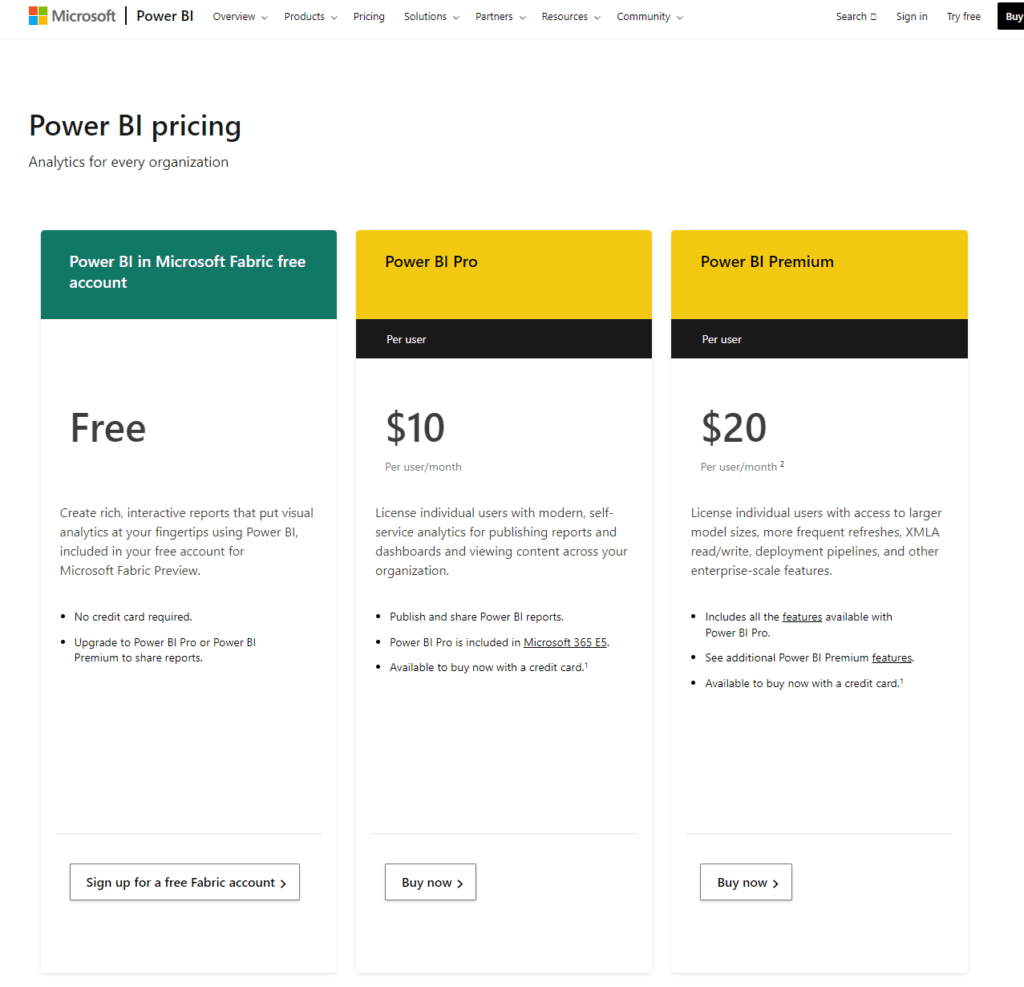In today’s data-driven world, where decisions hinge on insights gleaned from numbers, choosing the right analytics tool is more crucial than ever. On one side of the ring, we have Microsoft Power BI, a heavyweight contender known for its robust capabilities and integration prowess. On the other, Kissmetrics, a tool that prides itself on deep customer insights and behavioral analytics. Both promise to unlock the door to data-driven nirvana, but which key fits your lock? Let’s delve into the User Experience and Dashboard Usability to see how these tools measure up, ensuring you’re equipped with the information you need to chart your course through the data seas.
| Microsoft Power BI | Kissmetrics |
|---|---|
 |  |
| G2 Score -4.5 out of 5 | G2 Score -4.1 out of 5 |
| TrustRadius Score -8.3 out of 10 | TrustRadius Score -9.6 out of 10 |
User Experience and Dashboard Usability: The Map to Treasure
In the quest for actionable insights, the ease of navigating your analytics tool and the clarity of the dashboards it generates are akin to having a well-drawn map in a treasure hunt. A tool that offers a seamless user experience and insightful dashboards can transform a daunting data jungle into a navigable treasure island.
Microsoft Power BI: Navigating With Ease
Microsoft Power BI is celebrated for its intuitive interface and customizable dashboards, making it accessible for users of varying expertise levels. With its drag-and-drop functionality and wide array of visualization options, Power BI enables users to easily create reports and interactive dashboards that not only present data appealingly but also pack it with insights.
The integration with other Microsoft products enhances its usability, offering a familiar environment for those already versed in the Microsoft ecosystem. Moreover, Power BI places a strong emphasis on collaboration, making it easier for teams to share insights and make data-driven decisions together.
Kissmetrics: Insightful Journeys Through Customer Behavior
Kissmetrics, focusing on customer behavior analytics, offers a user experience tailored to uncovering deep insights into how users interact with your product or website. Its dashboards are designed to highlight key metrics that matter to marketers and product managers, such as conversion rates, funnel performance, and user engagement.
While Kissmetrics might not offer the same level of customization as Power BI, its strength lies in providing clear, actionable insights that help businesses understand and improve the customer journey. The platform’s emphasis on customer-centric data makes it a powerful tool for those specifically interested in optimizing marketing strategies and product experiences.
Data Integration Capabilities: The Confluence of Data Streams
The power of an analytics platform often lies in its ability to bring together disparate data sources, providing a holistic view of your business landscape. Here’s how Microsoft Power BI and Kissmetrics fare in their quest to integrate the scattered islands of data into a navigable map.
Microsoft Power BI: The Versatile Fleet
Microsoft Power BI shines with its broad integration capabilities, designed to connect with an extensive array of data sources, both on-premises and in the cloud. Whether it’s databases like SQL Server, Oracle, and MySQL, or cloud services such as Azure, Salesforce, and Google Analytics, Power BI ensures that businesses can unify their data streams for comprehensive analysis.
This wide-ranging connectivity is bolstered by Power BI’s adaptability to Microsoft’s ecosystem, offering advanced analytics and AI capabilities. For organizations navigating through diverse data landscapes, Power BI acts as a unifying force, adeptly bringing isolated data islands into comprehensive maps for exploration.
Kissmetrics: The Specialist Vessel
Kissmetrics, with its focus on customer behavior and marketing analytics, offers specialized integration capabilities that center around marketing platforms and tools. While its range of direct integrations might not be as extensive as Power BI’s, Kissmetrics excels in seamlessly pulling data from digital marketing channels, e-commerce platforms, and web analytics tools.
This focus ensures that marketers and product managers have a clear, unified view of customer interactions and campaign performance, enabling targeted analysis and optimization efforts. For businesses primarily concerned with marketing analytics and user behavior, Kissmetrics provides the necessary tools to navigate the specific currents of customer data.
Pricing: Setting the Sails for Investment
The cost structure of an analytics platform can significantly impact your ability to leverage it effectively within your organization. Let’s chart the pricing details of Microsoft Power BI and Kissmetrics to understand how they align with different budgetary requirements.
Microsoft Power BI: Flexible Pricing Seas

Microsoft Power BI offers a tiered pricing model, designed to accommodate a range of users and organizational sizes, this free offering allows individuals and small teams to begin their analytics journey, providing robust data visualization and basic analysis capabilities without any cost.
Priced at approximately $9.99 per user per month, this plan is aimed at professionals requiring more advanced collaboration, data refresh, and publishing capabilities. It’s suited for small to medium-sized businesses or teams within larger organizations. With pricing starting at $20 per user per month for premium per user (PPU) or $4,995 per month for a dedicated cloud computing and storage resource, this tier caters to large enterprises needing in-depth analytics, big data support, and advanced features like AI and paginated reports.
Kissmetrics: Tailored Pricing Voyages

Kissmetrics adopts a custom pricing approach, reflecting its focus on marketing analytics and customer behavior insights, Kissmetrics doesn’t publicly list standard pricing tiers. Instead, it offers personalized quotes based on the specific needs of a business, such as the number of events tracked, the size of the customer base, and required features.
This model ensures that businesses only pay for the capacity and capabilities they need. Interested businesses must contact Kissmetrics directly to discuss their requirements and receive a pricing proposal tailored to their unique situation.
Scalability and Performance: Navigating Through Growing Seas
Scalability and performance in the context of data analytics tools are crucial for ensuring that as your business expands and your data becomes more complex, your analytics platform can continue to deliver insights swiftly and efficiently. Let’s see how Microsoft Power BI and Kissmetrics hold up against the demands of expanding data horizons.
Microsoft Power BI: The Expansive Galleon
Microsoft Power BI is built on a robust architecture that supports scalability across a spectrum of business sizes, from small teams to large enterprises. Thanks to its integration with Microsoft’s cloud platform, Azure, Power BI can dynamically scale resources to handle large datasets and complex queries, ensuring users continue to receive fast and reliable insights regardless of the size of their data or user base.
Additionally, Power BI’s ability to integrate with various data sources and services means it can adapt to your business’s growing analytics needs, making it a solid choice for organizations planning for growth.
Kissmetrics: The Agile Clipper
Kissmetrics, with its focus on marketing analytics and customer behavior insights, offers scalability tailored to the specific needs of marketers and product managers. While it may not face the same broad scalability challenges as a general-purpose BI tool like Power BI, Kissmetrics is designed to efficiently handle large volumes of user data, ensuring that businesses can track and analyze customer interactions and campaign performance even as they scale.
Its cloud-based infrastructure allows for flexibility in data processing and analysis, ensuring that marketing teams can rely on Kissmetrics for fast, actionable insights, even as their data grows.

Related: Check out our free SEO suite

Reporting and Analysis Features: Charting the Course to Insights
The depth and flexibility of reporting and analysis features can significantly impact an organization’s ability to understand its data and make informed decisions. Let’s assess how Microsoft Power BI and Kissmetrics fare in providing these critical navigational tools.
Microsoft Power BI: The Cartographer’s Dream
Microsoft Power BI is renowned for its comprehensive reporting and analysis features, offering a rich set of tools that allow users to create highly detailed and customizable reports. Its capabilities include, with a wide variety of chart types and the ability to create custom visuals, Power BI enables users to represent data in the most insightful ways.
Interactive reports allow users to drill down into data, explore different scenarios, and uncover hidden insights. Power BI incorporates AI features, such as natural language querying and data-driven alerts, making it easier to explore data and receive notifications about significant changes or trends. These features make Power BI a powerful tool for organizations that need to dive deep into their data, offering the versatility to cater to a wide range of reporting and analysis needs.
Kissmetrics: The Navigator of Customer Journeys
Kissmetrics specializes in reporting and analysis features designed specifically for tracking and understanding customer behavior. Its strengths include, Kissmetrics provides detailed reports on customer actions, from acquisition through retention, enabling businesses to track the customer journey and identify areas for improvement.
By grouping users based on behaviors or characteristics, Kissmetrics allows for nuanced analysis of customer segments over time, revealing patterns and trends that can inform marketing strategies. This feature helps businesses identify where potential customers drop off during the conversion process, offering insights into how to optimize the user experience for better results. Kissmetrics’ focus on marketing analytics makes it an invaluable tool for businesses looking to understand and enhance their customer interactions and campaign performance.
Conclusion
Our exploration may have reached its harbor, but the sea of data analytics is ever-expanding. New technologies emerge, and the digital landscape evolves, beckoning with uncharted territories and new insights. The key to a successful voyage lies in choosing an analytics tool that not only meets your current needs but also possesses the agility to adapt to future challenges and opportunities. May the insights gathered on this journey illuminate your path, guiding you to the analytics tool that best aligns with your strategic goals, empowering your organization to harness the winds of data, and steering you toward new horizons of success and discovery.
Microsoft Power BI has shown itself as a versatile and robust flagship, equipped to guide organizations of all sizes through diverse data landscapes with its comprehensive integration capabilities, intuitive interface, scalable solutions, and flexible pricing. Kissmetrics, sailing a more specialized route, stands out for its focus on marketing analytics and customer behavior insights.
READ NEXT:
- IBM Cognos Analytics vs SAS Visual Analytics: The Best Analytics Tool for You
- Microsoft Power BI vs Optimizely: The Best Analytics Tool for You
- IBM Cognos Analytics vs Segment: The Best Analytics Tool for You
- Clicky vs Amplitude: The Best Analytics Tool for You
- Hotjar vs Baremetrics: The Best Analytics Tool for You
- 11 Marketing Analytics Tools to Elevate Your Data-Driven Strategies
- 29+ Digital Analytics Software to Skyrocket Your Digital ROI





















Comments are closed.